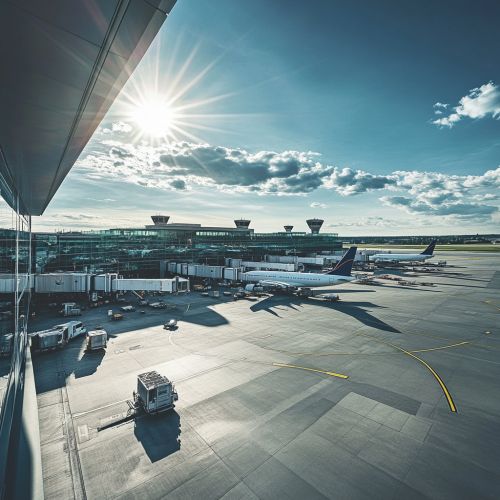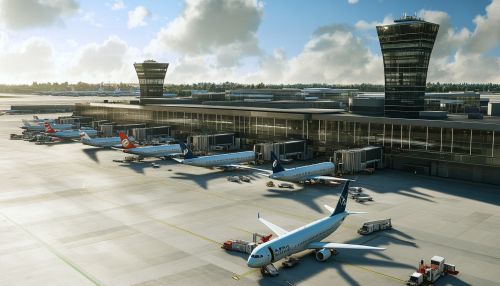John F. Kennedy International Airport
Overview
John F. Kennedy International Airport (JFK) is a major international airport located in Queens, New York City. It is one of the busiest airports in the United States and serves as a primary gateway for international travelers entering and leaving the country. JFK is operated by the Port Authority of New York and New Jersey and is named after John F. Kennedy, the 35th President of the United States.
History
Early Development
The airport was originally opened as Idlewild Airport on July 1, 1948. The site was chosen in 1941, and construction began shortly thereafter. The airport was built to relieve congestion at LaGuardia Airport and to accommodate the increasing demand for air travel. The initial construction included a single runway and a modest terminal building.
Renaming and Expansion
In 1963, following the assassination of President John F. Kennedy, the airport was renamed in his honor. The 1960s and 1970s saw significant expansion, including the addition of new terminals, runways, and taxiways. The introduction of jumbo jets, such as the Boeing 747, necessitated further infrastructure improvements to accommodate the larger aircraft.
Modernization Efforts
In the 1990s and 2000s, JFK underwent extensive modernization efforts. These included the construction of new terminals, such as Terminal 1 and Terminal 4, and the renovation of existing facilities. The AirTrain JFK, an automated people mover system, was introduced in 2003 to improve connectivity between terminals and provide a link to the New York City Subway and Long Island Rail Road.
Facilities
Terminals
JFK has six passenger terminals, numbered 1 through 8 (there is no Terminal 6 or 9). Each terminal is operated by different airlines or airline alliances and offers a range of amenities, including lounges, dining options, and retail stores.


- **Terminal 1**: Operated by a consortium of international airlines, including Lufthansa and Air France.
- **Terminal 2**: Primarily used by Delta Air Lines for domestic flights.
- **Terminal 4**: A major international terminal operated by the Schiphol Group, serving airlines such as Emirates and KLM.
- **Terminal 5**: Operated by JetBlue Airways, featuring a modern design and numerous amenities.
- **Terminal 7**: Operated by British Airways, serving international flights.
- **Terminal 8**: Operated by American Airlines, serving both domestic and international flights.
Runways and Taxiways
JFK has four runways, arranged in two parallel pairs. The runways are designed to accommodate a wide range of aircraft, from small regional jets to large international airliners. The airport also features an extensive network of taxiways, allowing for efficient movement of aircraft on the ground.
Cargo Facilities
In addition to passenger services, JFK is a major hub for air cargo. The airport has several cargo terminals operated by companies such as FedEx and UPS. These facilities handle a significant volume of freight, including perishable goods, electronics, and pharmaceuticals.
Operations
Air Traffic Control
JFK's air traffic control (ATC) is managed by the Federal Aviation Administration (FAA). The ATC tower coordinates the movement of aircraft on the ground and in the airspace surrounding the airport. The tower is equipped with advanced radar and communication systems to ensure safe and efficient operations.
Security
Security at JFK is overseen by the Transportation Security Administration (TSA). The airport features multiple security checkpoints, where passengers and their belongings are screened before boarding. In addition to TSA personnel, the Port Authority Police Department provides law enforcement services at the airport.
Ground Transportation
JFK is accessible by various forms of ground transportation. The AirTrain JFK provides a convenient link to the New York City Subway and Long Island Rail Road. Additionally, numerous taxi, ride-sharing, and shuttle services operate at the airport. There are also several parking facilities available for travelers who prefer to drive.
Environmental Impact
Noise Pollution
JFK is located in a densely populated urban area, and noise pollution is a significant concern. The airport has implemented various measures to mitigate noise, including the use of noise abatement procedures and the installation of soundproofing in nearby homes and schools.
Air Quality
The airport's operations contribute to air pollution in the surrounding area. Efforts to reduce emissions include the use of cleaner-burning jet fuels, the implementation of ground power units to reduce aircraft idling, and the promotion of public transportation options for passengers and employees.
Wildlife Management
JFK is situated near Jamaica Bay, a significant wildlife habitat. The airport has a comprehensive wildlife management program to minimize the risk of bird strikes and other wildlife-related incidents. This program includes habitat modification, the use of deterrents, and regular monitoring of wildlife activity.
Future Developments
Terminal Redevelopment
JFK is undergoing a multi-billion-dollar redevelopment program aimed at modernizing and expanding its facilities. This includes the construction of new terminals, the expansion of existing ones, and improvements to roadways and parking facilities. The goal is to enhance the passenger experience and increase the airport's capacity to handle future growth.
Sustainability Initiatives
As part of its redevelopment efforts, JFK is focusing on sustainability. This includes the use of energy-efficient building materials, the installation of solar panels, and the implementation of water conservation measures. The airport is also exploring the use of electric ground support equipment to reduce its carbon footprint.
See Also
- LaGuardia Airport
- Newark Liberty International Airport
- Port Authority of New York and New Jersey
- AirTrain JFK
- Federal Aviation Administration
